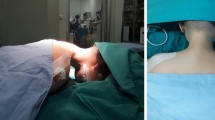Degenerative cervical disorders predominantly lead to anterior spinal cord compression (by bony spurs at the posterior margin of the vertebral body or by degenerated disc), which may be central and/or foraminal. In a smaller percentage of cases, there is encroachment of the canal mainly from posterior by bulging yellow ligaments or bony appositions, resulting in compression syndromes of roots or spinal cord. The aim of this work is to present a minimally invasive posterior approach avoiding detachment of muscles for the treatment of cervical radiculopathy and myelopathy. Thirteen patients suffering from cervical radiculopathy (four patients) or myelopathy (nine patients) were operated according to this technique. In principle, the technique secures access to the diseased spinal segment via a percutaneously placed working channel (11 mm outer diameter and 9 mm inner diameter). The cervical paraspinal muscles are not deflected, but just spread between their fibres by special dilators. All further steps are performed through this channel under control of three-dimensional vision through the operating microscope. The mean follow-up period was 17 months (one patient died 9 months postoperatively), and patients were evaluated using a modified version of the Oswestry Index, called the Neck Disability Index (NDI), and the visual analogue scale (VAS) for neck and arm pain. The mean NDI (P<0.0001) improved from 13.2 (preoperatively) to 4.8 (postoperatively). The VAS for arm pain (P<0.001) and for neck pain (P<0.001) also showed marked postoperative improvement. Complete recovery of the preoperative neurological deficit was found in four patients, while the remaining eight patients showed improvement of the neurological symptoms during the follow-up period. There were no intra-operative or postoperative complications and no re-operation. The preliminary experience with this technique, and the good clinical outcome, seem to promise that this minimally invasive technique is a valid alternative to the conventional open exposure for treatment of lateral disc prolapses, foraminal bony stenosis and central posterior ligamentous stenosis of the cervical spine.
Similar content being viewed by others
Author information
Authors and Affiliations
Additional information
Electronic Publication
Rights and permissions
About this article
Cite this article
Boehm, H., Greiner-Perth, R., El-Saghir, H. et al. A new minimally invasive posterior approach for the treatment of cervical radiculopathy and myelopathy: surgical technique and preliminary results. Eur Spine J 12, 268–273 (2003). https://doi.org/10.1007/s00586-002-0522-7
Received:
Revised:
Accepted:
Issue Date:
DOI: https://doi.org/10.1007/s00586-002-0522-7




